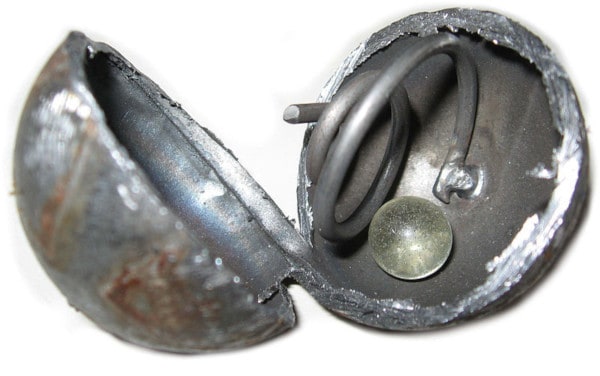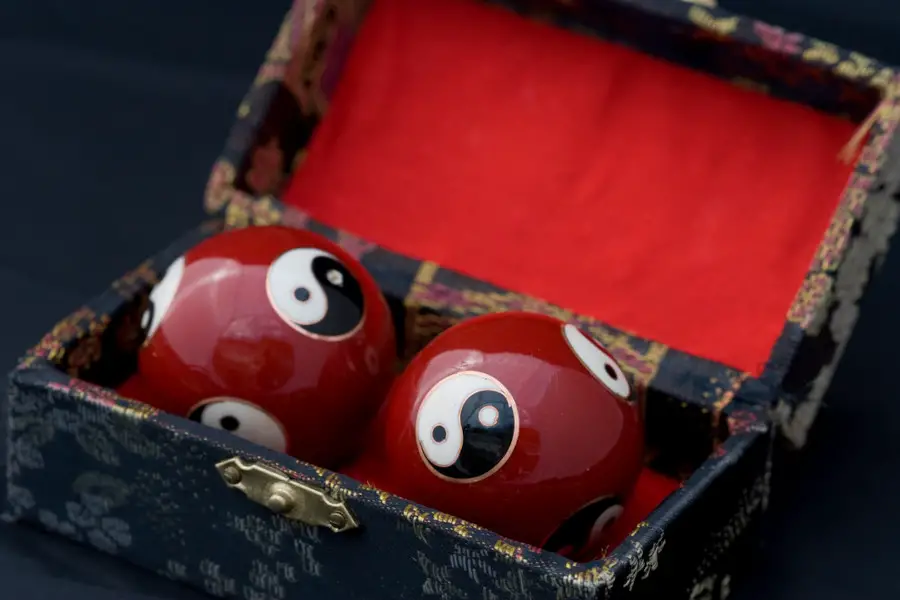
Baoding balls, also known as Chinese meditation balls, exercise balls, or sometimes Zen meditation balls, are a pair of relatively small balls, each of them small enough to be held in one hand.
Baoding balls are typically used by rolling both of them (or sometimes, more) repeatedly in the palm of your hand, where the relative positions of the balls are constantly switching. This exercise is intended to improve finger dexterity, and relaxation, as well as aid the recovery of motor skills and muscle strength after injury.
These balls are believed to improve brain function and reduce stress while they exercise your hand muscles, earning them the name meditation balls’.
Beginners using the Baoding balls usually find the balls maintain contact as they are rotated. Yet, with practice, we can rotate and manipulate these balls without having them touch each other.
Related reading: How to Use Feng Shui Principles to Make a Stress-free Home
History of Baoding Balls
Although the hollow Baoding balls we know today only came into existence during the Ming Dynasty (1368 to 1644 CE), the history of Baoding balls has begun as far as the times of the Han Dynasty (26-220 CE). The name Baoding balls’ itself comes from the Baoding city in Hebei province, where the balls are believed to have originated from.
However, the Han Dynasty archives didn’t actually show iron balls, but walnuts that are used to train the hands. It’s only during the Sung Dynasty (960-1279 CE) —many centuries later— that iron balls replaced these walnuts. This is also the time when the Baoding balls are also used as weapons, practiced in martial arts and Chinese acrobats. It is believed that the Baoding balls provided enhanced powers to help their strength and performance.
As mentioned, it is only during the Ming Dynasty that the hollow Baoding balls we know today were invented. It is believed that Emperor Jia Jing (1522-1567 CE) ordered his court to study the iron balls for their effects, and a method was then invented to create hollow balls (that is lighter and easier to manipulate) instead of solid iron design.
In the times of the Qing Dynasty, Emperor Qianlong (1736-1799) was prescribed by his physician to exercise his hands using the Baoding Balls every day. He went fond of these Baoding balls, which pushed them into cultural popularity. Qianlong was famous to be China’s longest-living emperor in its history, which further promoted the use of Baoding balls for good health.
During this period, the Baoding balls achieved mainstream popularity and were sought after by many people as one of the Three Treasures of Baoding (Baoding balls, potherb mustard, and flour sauce). Over the years, various methods were used to improve the design of the Baoding balls, including the technique of placing a smaller ball and a spring inside the ball to produce a pleasing musical chime.
Now, the Baoding balls also come in various designs and finishes from chrome-plated balls to cloisonne steel Baoding balls, and also in various sizes.
As with any products nowadays, Baoding balls come in various price points and quality: Baoding balls with/constructed of gemstones, copper balls, and solid steel/iron balls are considered high-quality, and gemstone balls are also popular since they are believed to possess metaphysical qualities. Some high-quality balls can also feature complex carvings and intricate patterns.
Over its long history, the Baoding balls have been called many names: Chinese stress balls, Chinese medicine balls, Chinese exercise balls, dexterity balls, meditation balls, harmony balls, or just Chinese balls. Some of these names signify the benefits these balls provide, which we will discuss below.
Related reading: “Traditional Chinese Games and Outdoor Activities”
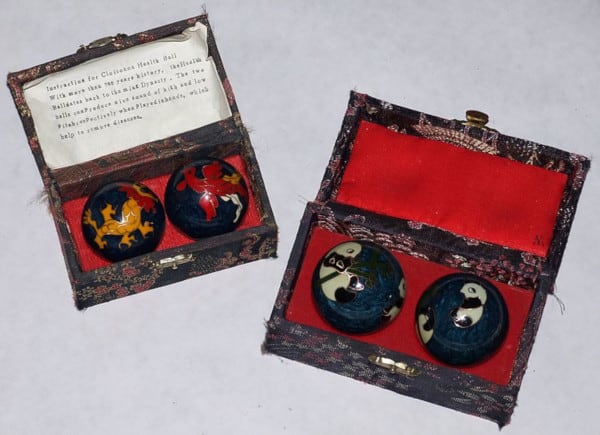
Benefits and Uses of Baoding Balls
As we’ve discussed, Chinese people have used the Baoding balls for centuries. Even today, doctors not only in China but all over the world sometimes recommend Baoding balls to patients who suffer from fatigue or hand/arm injuries (including post-surgery recovery). This is because the Baoding balls are believed to activate different meridian pressure points found in the palm of the hand.
In traditional Chinese medicine, we also believe the presence of Chi (or Qi), the life energy that flows through the body through channels we call meridians. Through these meridian lines, the fingers are connected to all the vital organs in the body including our brain, and Baoding balls are believed to stimulate these meridian points to restore the flow of chi.
Although the Baoding balls are mainly used in the hands and fingers, the rotating motion can benefit the whole body. With the pressures created by the Baoding balls’ movements, the patient’s internal energy flow is enhanced, which can produce the following benefits:
- Relieving stress and anxiety
- Relaxing muscles and joints
- Improved mental state and reduce memory loss
- Enhanced quality of sleep
While your hand muscles work while rotating the Baoding balls, your brain is actively engaged, creating a focused awareness and mindfulness (mind-body connection) to avoid distractions. Although the Baoding balls, as discussed, are often called “meditation balls”, they are rarely used in formal sitting meditation practice since they tend to be distracting.
However, rotating the balls is a meditation practice in itself, allowing us to focus on moving the balls, centering the mind to ease anxiety and regulate our minds.
Check out some “Baoding balls” designs (Aff-link)- Opens in new tab
How To Use Baoding Balls
While there are various different motions you can use with the Baoding balls, the basic practice is to rotate the balls. You can do this by pushing a ball down and along the palm by using your thumb while pushing the other ball using your pinky up and over.
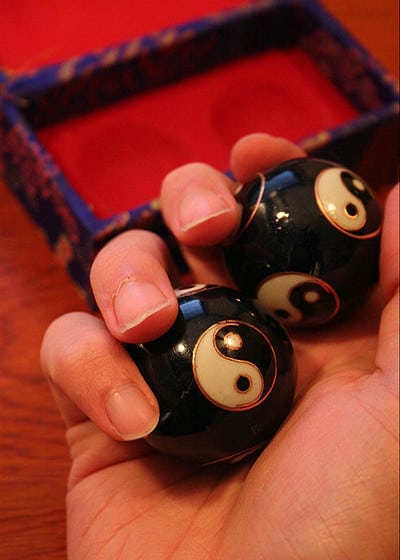
This movement might feel weird at first, so spend some time getting familiar with it and you can experiment with different movements. Have patience, do it slowly before speeding up, and it’s okay to drop the balls at first.
As you get more familiar with this movement, you can try to increase the speed, change direction, maintain a similar space between the balls throughout (so they don’t touch each other), and so on. Once you can effectively maintain a space between two balls, you can switch to heavier or bigger balls if you want. Also, you can try another pair in a different texture or material.
If you want even more challenge, there are various modifications to the exercise you can try. You can try moving one ball over the other repeatedly, or turn your palm to face down while you rotate the balls.
Don’t forget to switch between both hands or even practice with both hands simultaneously with coordinated movements. You can even use three or more balls if you want, although it may take some more practice.
How to Choose Your Baoding Balls
The first thing to consider when choosing different Baoding Balls is size. That is, what size works for your hand. If you can, try it before you buy so you can be sure that it is comfortable and easy enough for your hands to rotate. In general, choose 35-40mm balls if you have a small hand or if you are a beginner, and you can get 40-50 mm pair of balls if your hands are bigger.
A general rule of thumb is that you should be able to comfortably hold a ball between your thumb, index, and middle finger while using your pinky and ring finger to balance it.
The second thing to decide is whether you’d like a music chime inside the balls. In most cases, one ball will have a higher chime tone (representing the yang energy of the yin/yang principle) while the other ball will produce a lower chime tone (representing the yin energy). If, for example, you are planning to use the balls when commuting on public transport, then you might want to avoid getting ones with chimes.
Check out some “Baoding balls” designs (Aff-link)- Opens in new tab
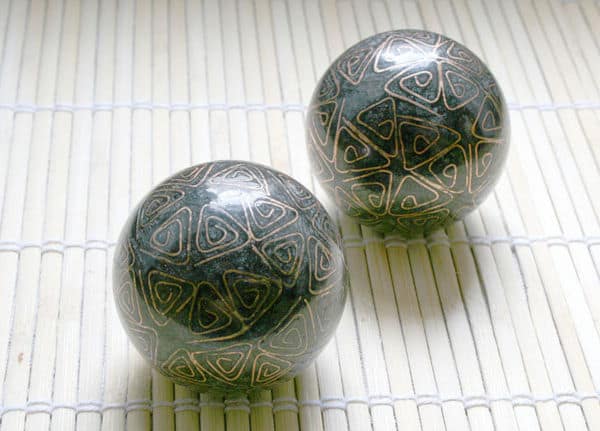
Last but not least, is about choosing between different designs and materials. Obviously, there’s no one way to do this, but you should try to find something you really love so you’ll be more motivated to use the Baoding balls regularly. As we’ve discussed, there are plenty of designs to choose from, with various different materials.
If you want extra health benefits, there are Baoding balls with little spikes or nubs all around the ball. These spikes can help stimulate your acupressure points more and will produce their own unique, pleasing sensation.
In general, you should choose a pair that is as close to perfect spheres as possible, and as smooth as possible. If you practice a lot, you should choose a robust finish that won’t easily wear off with regular practice.
End Words
Practicing with Baoding balls might be very difficult at first and might demand all your focus, but as you improve, it can be a great exercise to help relax your mind and muscles while training your focus. You can also incorporate elements of meditation, for example by practicing along with a song while maintaining the same rhythms.
Don’t forget to store them safely when they are not in use, certain finishes might also require a little bit of maintenance like a little polish to prevent rust and help them shine. Chrome Baoding balls, for example, might benefit from a little wax every now and then.
Stay in Touch
 Join our newsletter by using the forms on this website or click here!
Join our newsletter by using the forms on this website or click here! Follow us on Google News
Follow us on Google News Follow us on Facebook
Follow us on Facebook
Feature Image from Depositphotos

